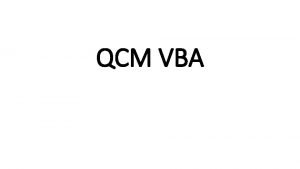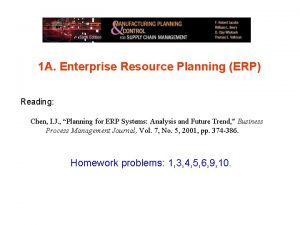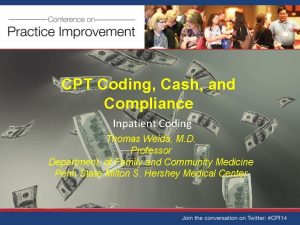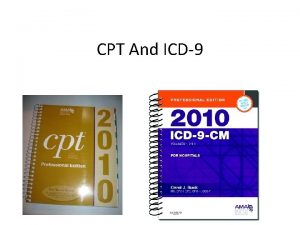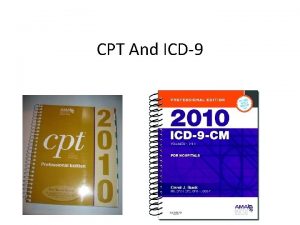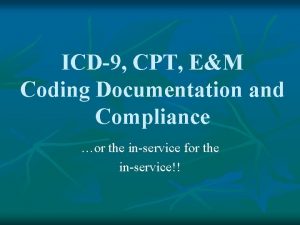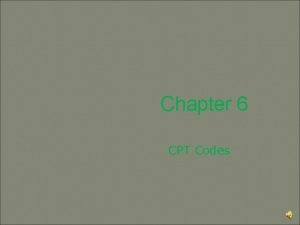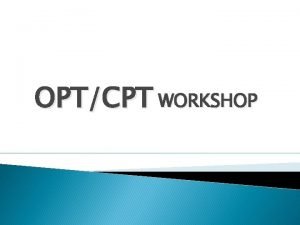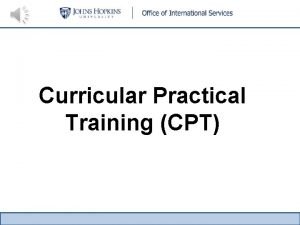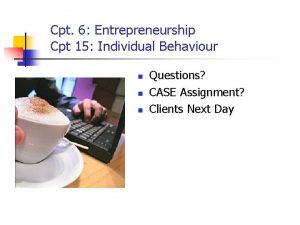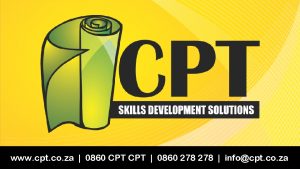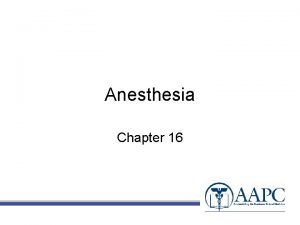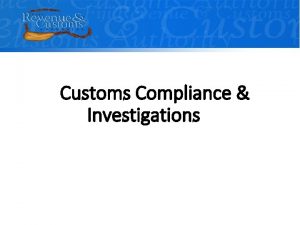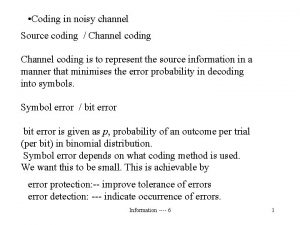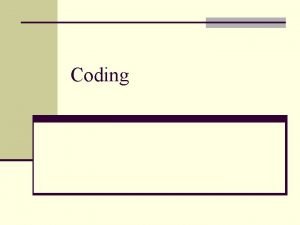CPT Coding Cash and Compliance Coding for cash













































- Slides: 45

CPT Coding, Cash, and Compliance Coding for cash: Getting the most for your hard work Thomas Weida, M. D. Professor Department of Family and Community Medicine Penn State Milton S. Hershey Medical Center

Disclosures • I have nothing up my sleeve. • I have nothing to disclose other than I’m on everyone’s best loved committee – the RUC

Objectives 1. Utilize proper documentation for CPT E&M coding 2. Apply proper CPT code use for common clinical situations, thereby avoiding under -coding or over-coding 3. Use medical decision making to guide E&M level 4. Discuss new CPT codes 12/4/2014 © 2014, Thomas J. Weida, 3

What will be discussed • • • Outpatient E&M Codes Inpatient E&M Codes Transitional Care Management Codes Chronic Care Coordination Codes Odds and Ends 12/4/2014 © 2014, Thomas J. Weida, 4

Office visit for a 32 year old female, established patient, with new onset RLQ pain. 1. 2. 3. 4. 5. 99211 99212 99213 99214 99215 12/4/2014 © 2014, Thomas J. Weida, M. D. 5

Office visit for a 70 year old female, established patient, with diabetes mellitus and hypertension, presenting with a 2 month history of increasing confusion, agitation and short term memory loss. 1. 2. 3. 4. 5. 99211 99212 99213 99214 99215 12/4/2014 © 2014, Thomas J. Weida, 6

Office visit for a 50 year old female with dyspepsia and nausea who you last saw in the office four years ago. 1. 2. 3. 4. 5. 6. 7. 8. 9. 10. 99201 99202 99203 99204 99205 99211 99212 99213 99214 99215 12/4/2014 © 2014, Thomas J. Weida, M. D. 7

New and Established Patient • New: A patient who has not received any professional services from the physician or another physician of the same specialty who belongs to the same group practice, within the past three years. • Established: A patient who has been seen within the past three years. 12/4/2014 New > Three Years © 2014, Thomas J. Weida, M. D. 8

Reasons For Not Coding Properly • • • Afraid of over coding and audit Takes too much time to document Don’t understand system Too complex Base coding on length of visit Charge does not seem reasonable 12/4/2014 © 2014, Thomas J. Weida, M. D. 9

Real Reasons for Not Coding Properly None Coding Captures What You Did, Not Reimbursement. It translates what you did into a 5 digit number 12/4/2014 © 2014, Thomas J. Weida, M. D. 10

Chief Complaint • Don’t forget to include it 12/4/2014 © 2014, Thomas J. Weida, M. D. 11

History • Physician must record chief complaint and HPI • Staff may record past medical, social and family history. • Staff may record review of systems. • Intake sheet can be used instead of staff asking questions for ROS & PFSH. 12/4/2014 © 2014, Thomas J. Weida, M. D. 12

History of Present Illness • • Location Quality Severity Duration Timing Context Modifying factors Associated symptoms 12/4/2014 © 2014, Thomas J. Weida, M. D. 4 Maximum needed for any code 13

Past History • • • Prior major illnesses and injuries Prior operations and hospitalizations Current medications Allergies(drug, food) Age appropriate immunization status Age appropriate feeding/dietary status 12/4/2014 © 2014, Thomas J. Weida, M. D. 14

Family History • The health status or cause of death of related family members • Diseases related to problems mentioned in the HPI or ROS • Hereditary diseases 12/4/2014 © 2014, Thomas J. Weida, M. D. 15

Social history • • Marital status or living arrangements Current employment Occupational history Use of drugs, alcohol and tobacco Level of education Sexual history Other relevant social factors 12/4/2014 © 2014, Thomas J. Weida, M. D. 16

Review of Systems • Constitutional (fever, weight loss) • Eyes • Ears, Nose Mouth, Throat • Cardiovascular • Respiratory • Gastrointestinal • Genitourinary 12/4/2014 • Musculosckeletal • Integumentary (skin or breast) • Neurological • Psychiatric • Endocrine • Hematologic/Lymph-atic • Allergic/Immunologic © 2014, Thomas J. Weida, 17

Streamlined History Note • CC: Abdominal Pain • HPI: 45 y/o female with 2 day history of constant, RLQ abdominal pain , 6/10 in intensity, which started after dinner, made worse by movement, and accompanied today by fever. • PFSH updated and reviewed on summary • ROS # of items reviewed per intake form 12/4/2014 © 2014, Thomas J. Weida, M. D. 18

Physical Exam Organ Systems Body Areas • Head • Neck • Chest including breast and axilla • Abdomen • Genitalia, groin • Back • Each extremity 12/4/2014 © 2014, Thomas J. Weida, M. D. • • • Eyes ENT CV Respiratory GI GU Musculoskeletal Skin Neuro Psych Heme, Lymph, Immuno 19

Established Patient Penn. State Hershey Medical Center 2 of 3 Element Hx Px Decision Making 99211 99212 99213 99214 99215 CC NA Required HPI NA 1 -3 4+ 4+ ROS N/A NA Pertinent 2 -9 10 PFSH N/A NA 1 of 3 1 of each Exam NA Focused Expanded Detailed Comp Dx/Mgt NA Minimal Limited Multiple Extensive Data NA Minimal Limited Moderate Extensive Risk NA Minimal Low Moderate High One self limited problem 2 Minor self limited problems One stable chronic problem Acute simple illness OTC Drug, PT, OT, Minor surg IV no additives 12/4/2014 1 or > chronic problem with progression or side effect 3 Stable Chronic Illnesses Undx new problem, uncertain px Acute complicated injury Prescription drug © 2014, Thomas J. Weida, location quality severity duration timing context modify fct assoc sx 2 of 3 1 or > chronic with severe exacerbation Threat to life or function Abrupt neuro change Parenteral controlled sub. Major surgery Rx with 20 intensive monitoring

New Patient Penn. State Hershey Medical Center 3 of 3 Element Hx Px Decision Making 99201 99202 99203 99204 99205 CC Required Required HPI 1 -3 4+ 4+ 4+ ROS N/A Pertinent 2 -9 10 10 PFSH N/A 1 of 3 1 of each 1 of each Exam Focused Expanded Detailed Comp Dx/Mgt Minimal Limited Multiple Extensive Data Minimal Limited Moderate Extensive Risk Minimal Low Moderate High One self limited problem 2 Minor self limited problems One stable chronic problem Acute simple illness OTC Drug, PT, OT, Minor surg IV no additives 12/4/2014 1 or > chronic problem with progression or side effect 2 Stable Chronic Illnesses Undx new problem, uncertain px Acute complicated injury Prescription drug © 2014, Thomas J. Weida, location quality severity duration timing context modify fct assoc sx 2 of 3 1 or > chronic with severe exacerbation Threat to life or function Abrupt neuro change Parenteral controlled sub. Major surgery Rx with 21 intensive monitoring

Medical Decision Making Putting It All Together Need Two of Three to Qualify for Level Overall MDM Problem Points Data Points Straightforward Complexity (992 x 2) 1 1 Minimal Low Complexity (992 x 3) 2 2 Low Moderate Complexity (992 x 4) 3 3 Moderate High Complexity (992 x 5) 4 4 High 12/4/2014 © 2014, Thomas J. Weida, M. D. Level of Risk 22

Medical Decision Making: Diagnosis/Management Options Problem Points Self limited or minor (maximum of 2) 1 each Established problem, stable or improving 1 each Established problem, worsening 2 each New problem, no additional work up planned (maximum of 1) 3 New problem, with additional work up planned 4 12/4/2014 © 2014, Thomas J. Weida, M. D. 23

Medical Decision Making: Data Points Data Reviewed Points Review or order clinical laboratory tests 1 Review or order radiology tests (except echo or heart cath) 1 Review or order medicine test (PFT, EKG, Cardiac Cath, Echo, etc. *) 1 Discuss test with performing physician 1 Independent review of tracing, image or specimen (i. e. EKG, KOH, UA) 2 Decision to obtain old records 1 Review and summation of old records 2 * EKGs, EEGs, PFTs, echocardiograms, cardiac catheterizations, cardiac stress tests, audiometry, speech or swallow studies, pacemaker interrogations, arterial or venous doppler studies, plethysmography, non-invasive arterial studies (such as ABIs), transcranial doppler studies, allergy testing, sleep studies, EMGs, evoked potentials, tensilon testing and nutritional assessments 12/4/2014 24 © 2014, Thomas J. Weida, M. D.

Medical Decision Making: Table of Risk – Highest Level Wins Risk Presenting Problems Diagnostic Options Management Options Minimal (992 x 2) Minimal Routine Labs, EKG, X-rays, USN, Echo, EEG Advice Low (992 x 3) Low PFT, Contrast X-rays, ABG, Skin OTC, PT, OT, Minor Surgery, IV – Biopsy no additives Moderate (992 x 4) Stress tests, endoscopies, Prescription Drugs, IV’s with Cardiac cath, LP, Thoracentesis additives, Major surgery – no risk factors, Minor surgery with risk, Closed fracture, Nuclear med treatment Medium High (992 x 5) High 12/4/2014 Cardiovasc imaging with risk factors, EP studies, Endoscopy with risk, Discography © 2014, Thomas J. Weida, M. D. Surgery with risk, Emergency surgery, Narcotics, Drug therapy with extensive monitoring, DNR decision 25

99215 Decision Making • 1 or more chronic illnesses with severe exacerbation, progression or side effects of treatment • Acute or chronic illnesses or injuries posing threat to life or function (MI, PE, Resp distress) • Abrupt neuro status change (TIA, Sx, weakness, sensory loss) 12/4/2014 © 2014, Thomas J. Weida, M. D. History 40 min • 4 HPI elements • 10 ROS • 1 of each PFSH Physical • Comprehensive (general multisystem or complete single organ) 26

99214 Decision Making • 3 chronic stable illnesses • 2+ or more chronic stable illnesses • 1+ chronic illness with exacerbation • Undiagnosed new problem with uncertain diagnosis • Acute illness with systemic symptoms • Acute complicated injury 12/4/2014 © 2014, Thomas J. Weida, M. D. History 25 min • 4 HPI elements • 2 -9 ROS • 1 of 3 PFSH Physical • Detailed (affected area and related organ system) 27

99213 Decision Making • 2 or more self limited problems • 1 stable chronic illness • acute uncomplicated illness (cystitis, sprain) History 15 min • 1 -3 HPI elements • Pertinent ROS Physical • Expanded problem focused 12/4/2014 © 2014, Thomas J. Weida, M. D. 28

99205 History Decision Making • 1 or more chronic illness with severe exacerbation, progression or side effects of treatment • Acute or chronic illnesses or injuries posing threat to life or function (MI, PE, Resp distress) • Abrupt neuro status change (TIA, Sx, weakness, sensory loss) 12/4/2014 © 2014, Thomas J. Weida, M. D. 60 min • 4 HPI elements • 10 ROS • 1 of each PFSH Physical • Comprehensive (general multisystem or complete single organ) 29

Looks like a 99215 99204 History Decision Making • 3 chronic stable illnesses • 2+ or more chronic stable illnesses • 1+ chronic illness with exacerbation • Undiagnosed new problem with uncertain diagnosis • Acute illness with systemic symptoms • Acute complicated injury 12/4/2014 © 2014, Thomas J. Weida, M. D. 45 min • 4 HPI elements • 10 ROS • 1 of each PFSH Physical • Comprehensive (general multisystem or complete single organ) 30

Looks like a 99214 99203 Decision Making • 2 or more self limited problems • 1 stable chronic illness • acute uncomplicated illness (cystitis, sprain) 12/4/2014 © 2014, Thomas J. Weida, M. D. History 30 min • 4 HPI elements • 2 -9 ROS • 1 of 3 PFSH Physical • Detailed (affected area and related organ system) 31

Medical Decision Making: Putting It All Together Established problem, stable or improving – 1 pt Established problem, worsening – 2 pt each New problem, no additional work up planned (maximum of 1) 3 pt Prescription Drugs Need Two of Three to Qualify for Level Overall MDM Problem Points Data Points Straightforward Complexity (992 x 2) 1 1 Minimal Low Complexity (992 x 3) 2 2 Low Moderate Complexity (992 x 4) 3 3 Moderate High Complexity (992 x 5) 4 4 High 12/4/2014 © 2014, Thomas J. Weida, M. D. Level of Risk 32

99212 99202 • One self limited problem • Focused exam • 1 -3 HPI elements 10 min • One self limited problem • Expanded problem focused exam • 1 -3 HPI elements • Pertinent ROS Looks like a 99213 12/4/2014 © 2014, Thomas J. Weida, M. D. 20 min 33

99211 • • • 5 min BP check by nurse Weight check for CHF Lab draw Picking up prescription refill Picking up return to work or school certificate. (If mail or call in, no CPT code allowed) • May not require physician presence • Document nurse activity and physician review “Coding from the Bottom Up, ” Thomas Weida, David O’Gurek, Family Practice Management, November 2008 12/4/2014 © 2014, Thomas J. Weida, M. D. 34

Time • The specific times expressed in the visit code descriptors are averages, and therefore represent a range of times which may be higher or lower depending on actual clinical circumstances. • Face-to-face for office and outpatient • Unit/floor for hospital and inpatient • Time is not a criteria for level of service. 12/4/2014 © 2014, Thomas J. Weida, M. D. 99205 – 60 min 99204 – 45 min 99203 – 30 min 99215 – 40 min 99214 – 25 min 99213 – 15 min 35

Counseling: The Time Component • Counseling: a discussion with a patient and/or family concerning: – – – Diagnostic results, or recommended studies Prognosis Risks & benefits of treatment Importance of compliance Risk factor reduction Patient and family education • Not just psychological counseling • If counseling > 50% of visit time, can use counseling documentation for level. • Document total time, counseling time and nature of counseling 12/4/2014 © 2014, Thomas J. Weida, M. D. 36

Signature • Your real or electronic signature is a critical component of the note • Sign them on a timely basis so billing can be submitted. 12/4/2014 © 2014, Thomas J. Weida, M. D. 37

Ideal frequency distribution 12/4/2014 © 2014, Thomas J. Weida, 38

Evaluation for a 28 year old male, established patient, with new onset of low back pain. Problem Points Self limited or minor (maximum of 2) 1 each Established problem, stable or improving 1 each 1. 99211 Established problem, worsening 2. 99212 New problem, no additional work up planned (maximum of 1) 3. 99213 New problem, with additional work up planned 4. 99214 5. 99215 12/4/2014 2 each 3 4 © 2014, Thomas J. Weida, M. D. Overall MDM Proble Data Level of m Points Risk Points Straightforwar d Complexity (992 x 2) 1 1 Minimal Low Complexity (992 x 3) 2 2 Low Moderate Complexity (992 x 4) 3 3 Moderat e High Complexity (992 x 5) 4 4 High 39

Review: 99214 • • 3 chronic stable illnesses 2+ or more chronic stable illnesses 1+ chronic illness with exacerbation Undiagnosed new problem with uncertain diagnosis • Acute illness with systemic symptoms • Acute complicated injury 12/4/2014 © 2014, Thomas J. Weida, M. D. 40

How many outpatient visits do you under-code a day? 1. 2. 3. 4. 5. 6. 7. 0 1 2 3 4 5– 7 >8 12/4/2014 © 2014, Thomas J. Weida, M. D. 41

Lost Revenue/Year Due to Undercoding • Medicare Rates Undercoded/day 1 2 3 4 5 8 Non facility $ 8, 331 $ 16, 663 $ 24, 994 $ 33, 326 $ 41, 658 $ 66, 652 Facility $ 6, 903 $ 13, 807 $ 20, 710 $ 27, 614 $ 34, 518 $ 55, 228 12/4/2014 © 2014, Thomas J. Weida, 42

Making It Happen • Pull 10 notes and check coding against easy to use guidelines. • Mentally calculate how much revenue lost • Kick self • Repeat process till no longer kicking self • Simple 12/4/2014 © 2014, Thomas J. Weida, M. D. 43

Follow the 6 Magic Slides And Get Paid for What You Do

Please evaluate this session at: stfm. org/sessionevaluation
 Axial coding
Axial coding Contoh open coding, axial coding selective coding
Contoh open coding, axial coding selective coding Vba
Vba Integumentary system cpt coding guidelines ppt
Integumentary system cpt coding guidelines ppt Coding dna and non coding dna
Coding dna and non coding dna Axial coding vs open coding
Axial coding vs open coding Cash-in cash-out
Cash-in cash-out Cash to cash cycle time
Cash to cash cycle time Cash to cash cycle time
Cash to cash cycle time The essentials of effective budgeting do not include
The essentials of effective budgeting do not include Paid cash to replenish the petty cash fund
Paid cash to replenish the petty cash fund List six reasons why a bank may dishonor a check
List six reasons why a bank may dishonor a check Kontinuitetshantering i praktiken
Kontinuitetshantering i praktiken Typiska novell drag
Typiska novell drag Tack för att ni lyssnade bild
Tack för att ni lyssnade bild Vad står k.r.å.k.a.n för
Vad står k.r.å.k.a.n för Varför kallas perioden 1918-1939 för mellankrigstiden
Varför kallas perioden 1918-1939 för mellankrigstiden En lathund för arbete med kontinuitetshantering
En lathund för arbete med kontinuitetshantering Kassaregister ideell förening
Kassaregister ideell förening Tidböcker
Tidböcker Sura för anatom
Sura för anatom Densitet vatten
Densitet vatten Datorkunskap för nybörjare
Datorkunskap för nybörjare Stig kerman
Stig kerman Hur skriver man en tes
Hur skriver man en tes Magnetsjukhus
Magnetsjukhus Nyckelkompetenser för livslångt lärande
Nyckelkompetenser för livslångt lärande Påbyggnader för flakfordon
Påbyggnader för flakfordon Formel för lufttryck
Formel för lufttryck Publik sektor
Publik sektor Kyssande vind
Kyssande vind Presentera för publik crossboss
Presentera för publik crossboss Jiddisch
Jiddisch Vem räknas som jude
Vem räknas som jude Treserva lathund
Treserva lathund Mjälthilus
Mjälthilus Bästa kameran för astrofoto
Bästa kameran för astrofoto Centrum för kunskap och säkerhet
Centrum för kunskap och säkerhet Byggprocessen steg för steg
Byggprocessen steg för steg Bra mat för unga idrottare
Bra mat för unga idrottare Verktyg för automatisering av utbetalningar
Verktyg för automatisering av utbetalningar Rutin för avvikelsehantering
Rutin för avvikelsehantering Smärtskolan kunskap för livet
Smärtskolan kunskap för livet Ministerstyre för och nackdelar
Ministerstyre för och nackdelar Tack för att ni har lyssnat
Tack för att ni har lyssnat Hur ser ett referat ut
Hur ser ett referat ut


